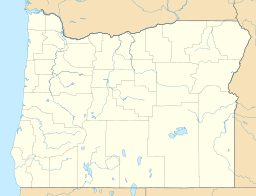McDermitt Caldera facts for kids
Quick facts for kids McDermitt Caldera |
|
|---|---|
| Highest point | |
| Peak | Jordan Meadow Mountain |
| Elevation | 6,816 ft (2,078 m) |
| Dimensions | |
| Length | 28 mi (45 km) north–south |
| Width | 22 mi (35 km) east–west |
| Geography | |
| Location | Harney County, Oregon Malheur County, Oregon Humboldt County, Nevada |
| Range coordinates | 42°00′05″N 117°59′48″W / 42.00139°N 117.99667°W |
| Geology | |
| Age of rock | 19 million years (Miocene) |
| Mountain type | Caldera |
| Last eruption | 16.39 ± 0.02 million years ago (Miocene) |
The McDermitt Caldera is a huge, oval-shaped caldera located in southeastern Oregon and northern Nevada, in the United States. It sits west of the town of McDermitt.
This ancient volcanic feature is about 28 miles (45 km) long from north to south. It is also about 22 miles (35 km) wide from east to west. Parts of the caldera are found within the Trout Creek Mountains and the Oregon Canyon Mountains. The highest point of the McDermitt Caldera is Jordan Meadow Mountain, which reaches 6,816 feet (2,078 m) high. This mountain is part of the Montana Mountains in Humboldt County, Nevada.
Contents
What is the McDermitt Caldera?
A caldera is a large, bowl-shaped hollow that forms when the ground collapses. This usually happens after a big volcanic eruption empties the magma chamber below. The McDermitt Caldera is thought to be the oldest in a series of calderas. These calderas were created by the Yellowstone hotspot, a super-hot spot deep inside the Earth.
How the Caldera Formed
Before the caldera formed, there was a lava dome in this area. A lava dome is a mound of thick, sticky lava that piles up around a volcanic vent. This dome was built by volcanic eruptions of a rock called rhyolite. These eruptions started about 19 million years ago.
The lava dome eventually collapsed between 16.37 and 16.41 million years ago. This huge collapse created the McDermitt Caldera we see today.
A Lake in the Caldera
After the caldera formed, a lake appeared inside it. This lake left behind special layers of sediment called varved sediments. These are layers of mud and silt that show seasonal changes. The lake also deposited diatomite, which is a soft, chalk-like rock made from tiny fossilized algae. Other materials found include opal and carbon-rich layers, along with dark, heavy lavas called mafic lavas.
Hidden Treasures: Minerals and Mining
The McDermitt Caldera holds important ore deposits deep underground. These include valuable minerals like mercury and uranium. During the 20th century, these minerals were mined at more than eight different locations within the caldera.
Mercury Mining
A lot of mercury was taken from mines in the caldera. Most of this mercury came from a bright red mineral called cinnabar. The McDermitt Mine, located on the eastern edge of the caldera in Nevada, was the last active mercury mine in the United States. It closed down in 1992.
Uranium Discoveries
Uranium was first found in the caldera in 1953. It was mainly dug out from a special type of rock called brecciated fault zone at the Moonlight mine. This mine is on the southwestern edge of the caldera. The main uranium minerals found there are uraninite and coffinite. Scientists believe the uranium formed around the same time as the caldera, about 16.1 million years ago.
Lithium: A New Resource
Other valuable minerals found in the caldera include antimony, cesium, and lithium. The Thacker Pass lithium deposit is located inside the caldera. In 2017, it was considered the most important source of lithium-clay in the U.S. Lithium is a very important metal used in batteries for electric cars and many electronic devices.
Images for kids
-
Kleinite, a rare yellow mineral containing mercury (formula: (Hg2N)(Cl,SO4)·nH2O) from the McDermitt Mine
-
McDermitt caldera geologic map





